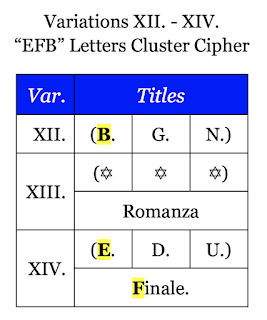What’s in a name? that which we call a roseBy any other name would smell as sweet.
Two of the Enigma Variations stand out from the rest because Edward Elgar gave them distinctly biblical names. The first is Variation VI with the subtitle Ysobel, a derivation from the Hebrew name Elishiba which means “God’s oath.” The second is Variation IX which is known by the venerable subtitle Nimrod, a figure described in the book of Genesis as “a mighty hunter before the Lord.” The similarities between these two movements go deeper than the scriptural origins of their subtitles. Both of these biblical subtitles are exactly six letters in length. In addition to having scriptural subtitles with an equal complement of letters, the Roman numerals assigned to Variations VI and IX represent the numbers six (6) and nine (9). These two glyphs are mirror inversions of one another. The multilayered parallels between Variations VI and IX strongly suggest Elgar was engaged in one of his favorite pastimes: Cryptography.
The unusual choice of scriptural names for Variations VI and IX is not random. On closer inspection, it turns out to be a simple acrostic phonetic cipher. The idea of an acrostic is subtly suggested by the opening motive of Variation VI which Elgar described as “an ‘exercise’ for crossing the strings . . .” The first letters of Ysobel and Nimrod are Y and N. When paired together, these two letters (YN) produce the phonetic equivalent of Ein. This reading is made possible when the y is pronounced as a long i such as in the word try. The acknowledgment of a phonetic version of Ein is significant because it s the first word in the covert Theme’s title, Ein feste Burg. It is not an incidental coincidence that the first three letters of the Theme’s title (Enigma) may be rearranged to spell Ein. The Teutonic genesis of the covert Theme is plainly suggested by the recognition that Elgar directed his only German friend portrayed in the Variations to write the subtitle Enigma above the Theme.
Elgar’s use of other acrostic ciphers in the Enigma Variations amply justifies a phonetic reading of the initials “YN” for Variations VI and IX as Ein. In the opening measure of the Enigma Theme, the first letters of the performance directions comprise an acrostic anagram for “EE’s PSALM.” This is a remarkable decryption because the title of the covert Theme originates from Psalm 46. The solution to Variation XIII’s enigmatic subtitle (✡ ✡ ✡) is cleverly encoded by an acrostic anagram from the initials of the adjacent movement’s subtitles for Variations XII (B. G. N.) and XIV (E. D. U. and Finale). The solution letters “EFB” are the initials for the covert Theme’s title, Ein feste Burg. There is a high probability that other similar acrostic anagrams remain to be discovered in the full score of the Enigma Variations.
Another plausible phonetic interpolation of the letters “YN” is wine. This reading is feasible when the Y is pronounced as the letter followed by the sound of N. Wine is a subject closely associated with Jesus, the secret friend portrayed in Variation XIII. At the outset of his public ministry, Jesus famously turned water into wine during the marriage at Cana. On the eve of the crucifixion, he celebrated the Last Supper with his disciples, an event that provides the scriptural foundation for the Eucharist. The liquid emblem of Christ’s sacrifice at Calvary symbolically flowed at both the beginning and the end of his earthly mission to impart the Gospel of God’s love, forgiveness, and reconciliation with humanity. Elgar was a Roman Catholic who dedicated the majority of his major works to God with the Jesuit motto “Ad majorem Dei gloriam.”
It has been shown that the phonetic descriptions of the Biblical Names Acrostic Cipher provide illuminating clues regarding the covert Theme of the Enigma Variations as well as the secret friend’s identity in Variation XIII. The construction of this cryptogram as an acrostic is not unique within the Enigma Variations as demonstrated by the Enigma Psalms and Letter Cluster ciphers. Elgar’s use of cryptography and Christian symbolism in the Enigma Variations is far more sophisticated and extensive than popularly believed by secular scholars. To learn more about the secrets behind one of Elgar’s most celebrated symphonic achievements, read my free eBook Elgar’s Enigmas Exposed. Please help support and expand my original research by becoming a sponsor on Patreon.



No comments:
Post a Comment
Please post your comments.